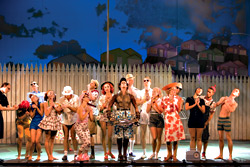A lot of ink has been spilled trying to define Matthew Bourne’s works. Are they ballet? Musical theater? Performance art? Past works, especially his controversial version of Swan Lake (with its corps de ballet of male swans), have had roots in concert dance, but as he changes the context, setting, or emphasis, he opens up the movement sources as well. Carmen becomes The Car Man, shifting from a cigarette factory to an auto shop and taking its cues from that new environment. There are generous helpings of classical ballet and theater dance in Bourne’s Edward Scissorhands, based on the Tim Burton film, but there are also examples of just about everything else, from jazz to mime to social dance.
Burton’s film is already a kind of revision, with Edward a sensitive Frankenstein transported to the dangerous suburbs. Edward’s yearning for acceptance and affection is just as powerful here, as Bourne unerringly puts his finger on the emotional center of the work. In fact, some of the events and characters are conveyed more succinctly in movement than in the talky narrative of the film. A cemetery tableau that segues into the creation of Edward, or the hectoring preacher’s wife leading her family in song, elicits a visceral response immediately, with no dialogue, no song lyrics, and only a couple of phrases projected on the scrim. Few artists have tried a shift this radical before. Recently Susan Stroman’s Contact was a successful experiment, but even a choreographer as skilled as Twyla Tharp relied on Billy Joel’s song lyrics in her Movin’ Out.
Despite its essential tragedy, Bourne’s Scissorhands has a cartoonlike brightness, taking visual cues from 1950s advertising illustrations, Disney’s Silly Symphonies, and 1960s Beach Party movies, to name just a few. The stereotypical families of Hope Springs come piling out of tiny houses like circus clowns from a Volkswagen Bug: the sexpot with the shifting hips, the perennially pregnant mother with a line of children, the perfect housewife with an oversized apron. Designer Lez Brotherston is a frequent collaborator with Bourne, and the forced perspective of his suburban houses leads us directly into this skewed world. Terry Davis’ score, borrowing from Danny Elfman’s music for the film and played live but heavily amplified, illustrates the disturbing side of perky in the scenes from that world, as well as Edward’s more straightforwardly melancholy life.
The Burton view of Edward’s experiences isn’t always child-safe, while Bourne’s work resembles a Christmas panto, an English holiday family tradition. Bourne also uses staging conventions from classic musical theater, even ending the first act with a big production number—a ballet with characters from a topiary garden, boxwood sculptures waltzing, and the dancing trees of a Disney cartoon. Bourne may borrow from the standard playbook, but he doesn’t subvert the core nature of the story.








